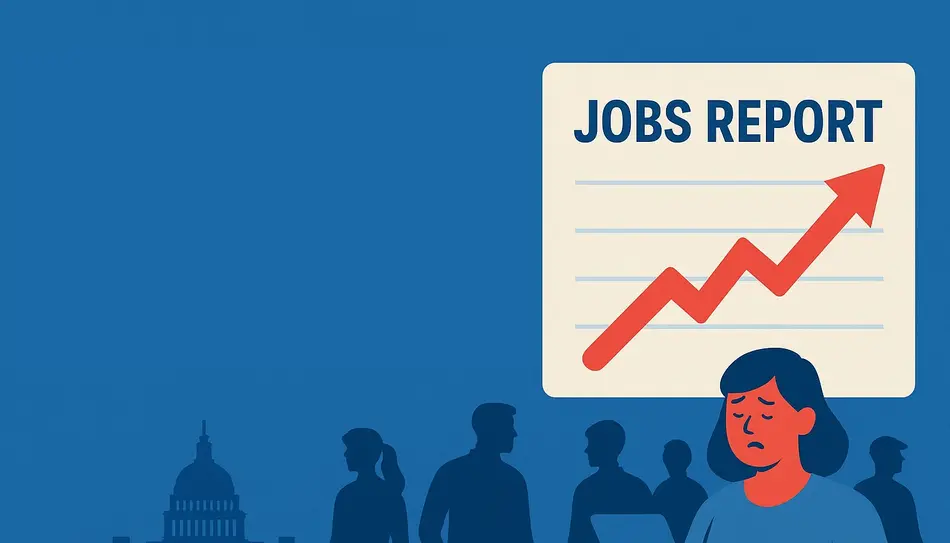US labor market resilience continues to surprise economists as the latest Bureau of Labor Statistics report shows 147,000 new jobs created in July, significantly outpacing the projected 106,000, while unemployment unexpectedly dropped to 4.1%.
Breaking Down the Latest US Labor Market Resilience Data
The newly released employment figures paint a picture of remarkable US labor market resilience despite ongoing economic concerns. The Bureau of Labor Statistics’ July report revealed several key indicators that suggest the job market remains stronger than many analysts anticipated:
- 147,000 new jobs created (41,000 above economist forecasts)
- Unemployment rate fell to 4.1% (better than the 4.3% forecast)
- Private payrolls increased by 74,000
- Jobless claims dropped to 233,000 from the previously reported 237,000
- Labor force participation steady at 62.3%
These numbers collectively indicate that despite recession fears and Federal Reserve interest rate policies, the US labor market continues to demonstrate unexpected strength and stability.
Wage Growth and Working Hours
A notable aspect of the latest report is the moderation in wage growth, which could have significant implications for inflation concerns:
- Average hourly earnings increased by just 0.2%
- Annual wage growth slowed to 3.7% from 3.9%
- Average weekly hours remained stable at 34.2
This cooling in wage growth may provide the Federal Reserve with additional flexibility in its monetary policy decisions, potentially allowing for rate cuts without triggering renewed inflation.
Historical Context of US Labor Market Resilience
The current US labor market resilience follows a pattern of defying expectations throughout the post-pandemic recovery. Since 2021, employment figures have consistently surprised to the upside, challenging traditional economic models and forecasts.
Job creation has remained robust even as the Federal Reserve implemented one of the most aggressive interest rate hiking cycles in decades. This unusual resilience has prompted economists to reconsider traditional assumptions about the relationship between monetary policy and employment.
Revisions and Long-Term Trends
The report also included revisions to previous months’ data:
- A net addition of 16,000 jobs to previous reports
- Continuing claims holding steady at 1,964,000
- Trade balance at $71.5 billion (close to the forecast of $71 billion)
These revisions, while modest, further reinforce the narrative of US labor market resilience and suggest that the employment situation may be even stronger than initially reported.
Implications for Economic Policy and Business Planning
The unexpected US labor market resilience has significant implications for both policymakers and businesses. For the Federal Reserve, the strong jobs data may complicate decisions about the timing and pace of potential interest rate cuts.
For businesses, the continued strength in employment suggests consumer spending may remain robust, supporting economic growth even as other indicators point to potential slowdowns. However, the tight labor market also means companies may need to continue offering competitive compensation packages to attract and retain talent.
Sector-Specific Performance
While the report doesn’t break down job growth by sector, previous patterns suggest that service industries, healthcare, and technology continue to drive employment gains. Manufacturing and construction have shown more variable performance, reflecting broader economic uncertainties and housing market challenges.
Companies in growth sectors may need to develop innovative recruitment strategies to secure needed talent in this persistently tight labor market.
Bureau of Labor Statistics Employment Situation Summary provides additional details on these trends, including demographic breakdowns and industry-specific data.
Regional Variations in US Labor Market Resilience
The national figures mask significant regional variations in employment strength. States with diverse economic bases and strong technology sectors have generally shown greater US labor market resilience than those heavily dependent on single industries.
Urban centers continue to outpace rural areas in job creation, though remote work has begun to redistribute some opportunities. This geographic disparity in employment opportunities presents both challenges and opportunities for workforce development initiatives.
Explore Job Opportunities in Growing Sectors
Related Post: Explore Top Jobs on WhatJobs
- Discover thousands of opportunities across multiple industries
- Filter by location, salary range, and experience level
- Create job alerts for immediate notifications of new openings
- Access employer reviews and salary information
- Connect directly with hiring managers
Future Outlook for US Labor Market Resilience
Looking ahead, several factors will influence the continued US labor market resilience:
- Federal Reserve policy decisions – The timing and magnitude of potential rate cuts
- Global economic conditions – Trade relationships and international market stability
- Technological disruption – AI and automation impacts on employment patterns
- Demographic shifts – Aging workforce and changing participation rates
- Fiscal policy changes – Government spending and tax policy adjustments
Economists remain divided on whether the current labor market strength can be maintained through 2024, with some predicting a gradual cooling while others expect continued robust performance.
Preparing for Potential Changes
For job seekers and employers alike, the key to navigating this uncertain environment lies in flexibility and continuous skills development. Career planning resources can help workers position themselves for success regardless of how employment trends evolve.
FAQ About US Labor Market Resilience
What does the recent US labor market resilience mean for recession predictions?
The continued US labor market resilience challenges widespread recession predictions. With job creation exceeding expectations and unemployment remaining low, the economy appears more robust than many analysts anticipated. However, other economic indicators still suggest caution, creating what economists call a “mixed signal” environment.
How is US labor market resilience affecting wage growth?
Despite the overall US labor market resilience, wage growth has moderated to 3.7% annually, down from 3.9%. This suggests that while employers still need to compete for talent, the extreme wage pressures seen in 2021-2022 have eased somewhat, potentially helping to contain inflation without significantly impacting employment levels.
Can US labor market resilience continue if the Federal Reserve maintains high interest rates?
The surprising US labor market resilience despite high interest rates has confounded traditional economic models. While sustained high rates would typically be expected to cool employment growth, the current labor market has shown remarkable adaptability. However, many economists believe there are limits to this resilience if restrictive monetary policy continues for an extended period.
How should job seekers respond to current US labor market resilience?
Job seekers should leverage the current US labor market resilience by being strategic in their search. The strong overall numbers don’t mean every sector is thriving equally. Focus on developing in-demand skills, research growing industries, and consider how your existing experience might transfer to more resilient sectors of the economy.
The latest employment report reinforces the narrative of an economy that continues to defy conventional wisdom. While challenges certainly remain, the US labor market resilience provides a foundation of stability that few predicted would persist this far into the Federal Reserve’s tightening cycle.
By staying informed about these trends and preparing for multiple scenarios, both workers and businesses can position themselves to thrive regardless of how economic conditions evolve in the coming months.




